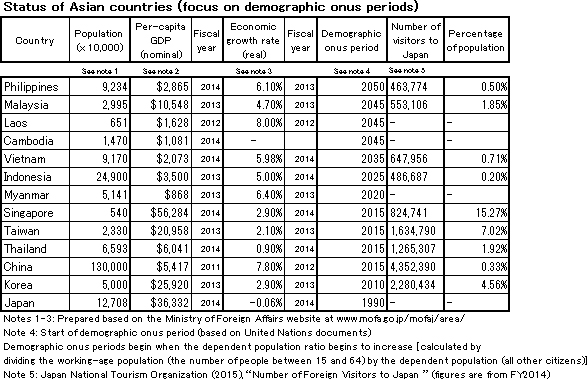Top>Opinion>ASEAN Countries: The Future of Japanese Business
 Index
Index
ASEAN Countries: The Future of Japanese Business
Hiroshi Nakamura
Dean, Business School, Chuo University
Areas of Specialization: Distribution strategy theory, marketing strategy theory
Japan’s graying society, falling birthrate, and dwindling population
The Japanese population is declining now as people age and have fewer children. This situation will only persist, and in the process will put our domestic market in a permanent state of shrinkage. In fact, Japan is the only developed nation to simultaneously experience both a graying society/low fertility rate and a population decrease, and this lack of precedent makes the future of our country even more uncertain.
Low birthrates and an aging population trigger permanent labor shortages, which may be good news for college students, but are a severe problem in terms of corporate operations. There are ways to counteract these shortages, such as bringing in immigrants or making extensive use of robots, but all of these solutions take time. Meanwhile, there is no denying that domestic demand is eroding as a result of population decline, a situation that made many industries and companies pessimistic about their future performance. Rural areas like the Tohoku and Shikoku regions are already experiencing serious population loss and the resulting economic stagnation.
So what are companies to do given these economic conditions? The most straightforward solution is to expand overseas, and the best business opportunities for Japanese firms are right here in Asia—where countries like China, Korea, Taiwan, the ASEAN member states, and India are experiencing robust economic growth coupled with rising demand thanks to a burgeoning middle class. The ASEAN countries in particular represent a golden opportunity thanks to the economic expansion brought about by the ASEAN Economic Community, or AEC. In addition, the increase in consumption among inbound foreign tourists will expose visitors to quality purchasing experiences in Japan—experiences that are very likely to make them seek out Japanese products upon returning to their home countries. I’m convinced that there is great potential for Japan to do business in Asia, particularly in the ASEAN member states and even more specifically in countries like Thailand, the Philippines, and Vietnam.
Spotlight on growth in ASEAN markets
There are several reasons we are now turning our attention to the ASEAN member states. To start, let’s look at the rise of the middle class that comes with economic growth in these countries, coupled with the delayed end of their demographic bonus periods and entry into demographic onus periods. Demographic bonus periods occur when the number of children has fallen and the population is comprised of a large working-age population with fewer elderly citizens. Social security costs go down due to an abundant labor force, making it easy for economic development to take place. Japan’s demographic bonus period started around 1960 (the beginning of its economic boom) and lasted until about 1990 when the bubble economy collapsed. A demographic onus, on the other hand, describes a period when the population composition change affects the economy negatively. The word onus means a burden or heavy load, and in this case it refers to the situation that a relatively small working population must support an even greater number of people. Japan entered its demographic onus period around 1990, and the country’s working population is now suffering under the increasing burden of supporting its retired population through its social security programs, with economic slowdown as a result.

Table 1. Economic growth in Asia (excluding India) and number of foreign tourists visiting Japan
As table 1 shows, real economic growth rate in the ASEAN member states was around 5% between 2012 and 2014, which is high even for Asia. Countries like Korea and Taiwan are at around 2%, while Japan’s economy is shrinking. Many ASEAN countries still have several years to go before they enter demographic onus periods, when the percentage of dependents supported by their working population begins to increase. If we look at the Philippines, for example, we see that the real economic growth rate is 6% and the demographic onus period will not start until 2050 (see table 1). This means that the country’s economic growth will continue for some time, making favorable market conditions possible. Malaysia shows a growth rate of 4.7% and a demographic onus starting in 2045; Laos is at 8% with a 2045 start date, Vietnam is at 6% and 2035, Indonesia at 5% and 2025, and Myanmar 6.4% and 2020. China has a high 7.8% economic growth rate, but it has already entered its demographic onus period, casting doubt as to whether the current boom can continue. Taiwan and Korea have similarly entered their demographic onus periods already, which will likely make it difficult for them to continue to achieve the high economic growth rates of the recent past.
Inbound vs. outbound demand
Looking at inbound demand, 12.73 million foreign tourists visited Japan from other Asian countries in fiscal 2014—and this number is set to hit to the 20 million mark in fiscal 2015. As a result of buying sprees by overseas visitors, Japan is seeing an increase—though slight—in its retail sales, particularly at department stores whose sales were previously decreasing. What I expect with this trend is that these tourists will want to recreate their Japan purchasing experiences upon returning from their inbound shopping sprees, and will start seeking out Japanese (Cool Japan) products in their home countries as well. For example, we see in table 1 that 15.27% of the population of Singapore has visited Japan—more than any other country on the list. As anyone who has been to Singapore will tell you, Japanese products (including Japanese restaurants) are extremely popular there, and this is further bolstered by a country-of-origin effect driving up prices. You can buy a bowl of local ramen for around five Singapore dollars (each worth about 90 yen), for example, while ramen at a Japanese restaurant costs more than ten. Part of the higher pricing is surely due to the distribution costs associated with getting the Japanese ingredients to Singapore, but the point is that people are willing to pay it.
With the rise of the middle class in Asia, we will undoubtedly begin to see foreign visitors not only from China, Taiwan, and Korea, but from the ASEAN member states as well. Cool Japan products, coupled with competent, warm Japanese-style service will give inbound visitors a purchasing experience that will attract more of them to the Cool Japan culture, with the end result that inbound demand will start to stimulate outbound demand as well.
Conclusion
My specialty is distribution theory, with a particular focus on research into the retail industry and the shoppers that visit retail outlets. Japan’s retail business is seeing its sales and profits erode year after year, but with increasing demand from inbound foreign tourists from other parts of Asia—particularly with Chinese shoppers going on buying sprees here in Japan—some companies are starting to experience partial improvement. That said, we can’t count on binge shopping forever and must treat it as a temporary phenomenon. Going forward, I believe that a strategic key to keeping Japan’s manufacturers and retailers alive will be for them to actively target the ASEAN member states with Cool Japan products and services, both in terms of inbound and outbound demand.
- Hiroshi Nakamura
Dean, Business School, Chuo University
Areas of Specialization: Distribution strategy theory, marketing strategy theory - Dean Hiroshi Nakamura graduated from School of Commerce, Waseda University and has a Doctor of Business Administration from Gakushuin University.
He taught at Senshu University and Business School at Chuo University as a professor before taking up the current post.
His areas of specialization are distribution strategy theory and marketing strategy theory.
His major publications include Marketing New Products [Shin Seihin no Maketeingu] (Chuokeizai-sha), Market Segmentation – The Discovery of Market Opportunities Using Purchasing History Data – [Maketto Segumenteshon – Kobai Rireki Deta o Mochiita Shijo Kikai no Hakken –] (author/editor, Hakuto-Shobo), Shopper Marketing [Shoppa Maketeingu] (co-author, Nikkei), and serial interviews with top retailers in Distribution Information (Strategies of Leaders) [Ryutsu Joho (Rida no Senryaku)].
- Research Activities as a Member of Research Fellowship for Young Scientists (DC1), Japan Society for the Promotion of Science (JSPS) Shuma Tsurumi
- Important Factors for Innovation in Payment Services Nobuhiko Sugiura
- Beyond the Concepts of Fellow Citizens and Foreigners— To Achieve SDGs Goal 10 “Reduce Inequality Within and Among Countries” Rika Lee
- Diary of Struggles in Cambodia Fumie Fukuoka
- How Can We Measure Learning Ability?
—Analysis of a Competency Self-Assessment Questionnaire— Yu Saito / Yoko Neha - The Making of the Movie Kirakira Megane









